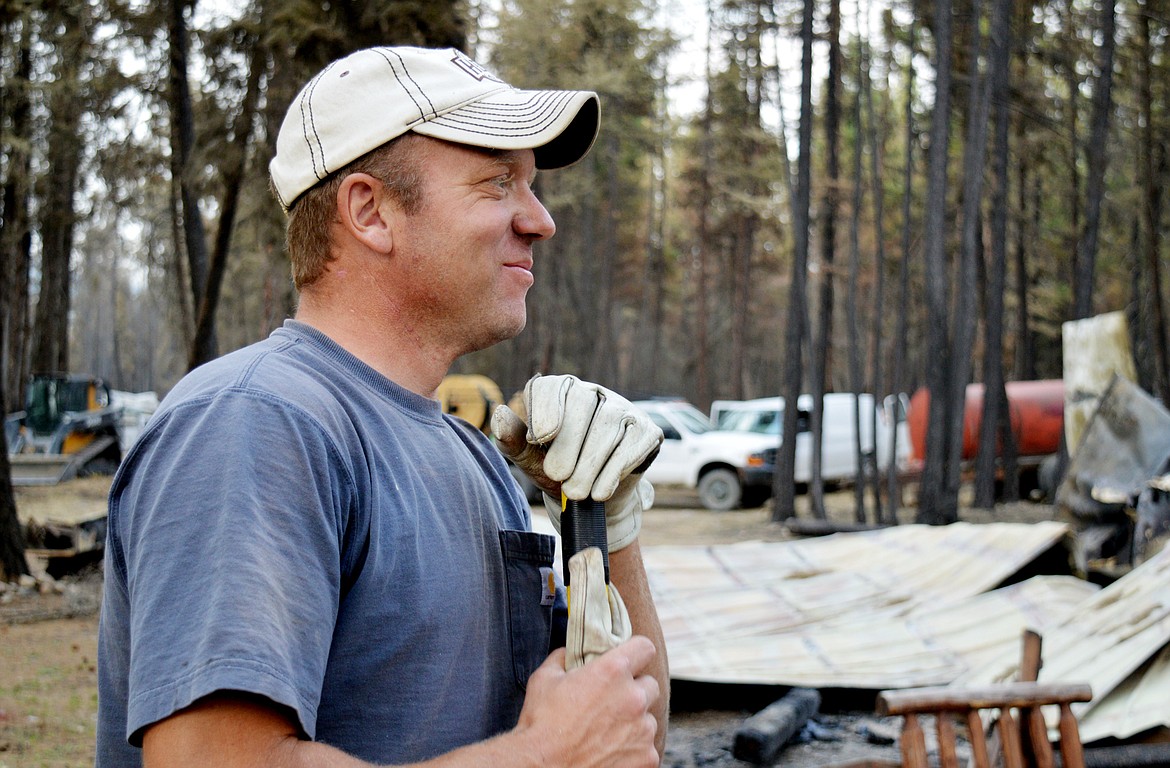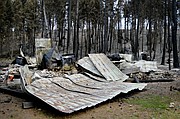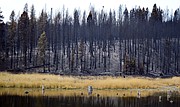Residents begin to regroup in wake of Caribou Fire
Standing in nearly 3 inches of ash, West Kootenai resident Ian Caswell sifted through the blackened pile of rubble days after the Caribou Fire consumed his home of 15 years in the northwest corner of Montana.
On Sept. 2, conditions aligned perfectly for one of the largest fire runs of Montana’s 2017 fire season, and for Caswell, the timing could not have been worse.
Hours earlier on that same Saturday afternoon, Caswell was married in a small church down the road from his property off West Kootenai Road.
He and around 25 of his friends and family were just sitting down to a reception dinner when Lincoln County Sheriff Robby Bowe pulled up the driveway.
A pre-evacuation warning had gone into affect earlier that day as the forecast called for high temperatures, high winds and low humidity, a winning combination on an active fire day, according to Caribou Fire Information Officer Ralph Swain.
Caswell and his family had most of their belongings packed and a trailer ready to load in case the evacuation call came, but the wedding continued as planned.
“Nobody really knew that it was coming that fast,” Caswell said. “We just weren’t ready.”
Barely two hours after the wedding, the newlyweds’ reception, held on Caswell’s scenic 13-acre property of dense forest, was interrupted as the audible roar of the approaching fire grew louder and the sheriff jumped out of his truck, informing them they had only moments to evacuate.
The fire, less than a quarter mile away, was still hidden from view as Caswell and his guests began grabbing armloads of his family’s belongings and loading them into various vehicles.
“We didn’t know it. We could hear it, but we didn’t know it was right there,” Caswell said.
Flames fueled by dry timber and howling winds jumped from treetop to treetop, racing across the canopy and throwing embers into the air to ignite the forest in front of it.
“It was just moving like a freight train,” Swain said. “[The trees] were like candlesticks. It was just moving straight across.”
Heat and flame finally emerged from the surrounding forest as the wedding party fled, leaving Caswell’s home to burn in the rearview mirror.
Farther down the ridge, firefighters scrambled to lay hoses and sprinklers in a short-handed attempt to halt the unexpected spread and protect the people and structures in its path.
Though precautions were in place and the teams were prepared for an active fire day, Swain said the 4-mile run the fire took on the evening of Sept. 2 and into Sept. 3 was both unexpected and unusual.
“By the time we knew it was making its run, it was making its run,” he said.
The Caribou Fire was discovered Aug. 11, and since then has spread to engulf more than 24,000 acres.
The lightning-caused fire, located 18 miles northwest of Eureka, continues to burn in heavy timber and is the largest of three wildfires in the area under the jurisdiction of Pearson’s Type 2 Incident Team.
According to Swain, the fire’s 4-mile run began so quickly and the wind was so rough that air operations were unable to get off the ground. The team over the fire’s management was forced to work with the limited resources they had available.
“We had two hotshot crews already in the area, which is great but not enough,” Swain said. “Not for a run like that.”
Around 175 firefighters made up the two crews that were suddenly responsible for the protection of the entire West Kootenai community.
Without the aid of helicopters or scooper planes, the crews were forced to fight the rapidly approaching fire by cutting hazardous trees, digging lines and using hoses and engines to spray down potential fuels.
Sheriff’s deputies dispersed across the pre-evacuation area to get residents out ahead of the blaze.
Of the 400 homes in the area, over at least two thirds were evacuated that day.
All 170 plus residents managed to escape ahead of the fire, but, despite their best efforts, firefighters were unable to save all of their properties.
It would be days before Caswell and his neighbors in the Spring Creek area would be allowed to return for their first glimpse of the full impact of the wildfire.
Over the course of a two-day period, 10 homes and around 30 outbuildings were destroyed.
Caswell and his family, escorted by law enforcement, returned on Sept. 5 to a blackened forest and three piles of rubble where Caswell’s house, his mother’s cabin and a barn once stood.
Though Caswell said he was mostly packed and ready to go at the time of the evacuation, the fire came so quickly that in the commotion, his four pack llamas, used for mountain treks, had to be left behind.
Though he had ripped out the fencing on their enclosure before fleeing, he returned to find two burned corpses among the debris.
“I couldn’t believe it,” he said. “I guess I just kept figuring I might wake up.”
Between the three structures, Caswell said he suffered pretty much a 100 percent loss.
However, a ray of hope remains on the horizon.
Two of his llamas somehow survived, and amidst the 13-acres of blackened land remains about half an acre of unburned soil.
There, Caswell said, he plans to rebuild his home, cut down the burned trees and plant new ones.
“I didn’t really want to rebuild at first because I was just disgusted,” Caswell said. However the progress he and his construction crew have made over the past week, he said, has given him hope.
Over the next week, he and several workers will dig a foundation for a new house and work to restore electricity and water to the property.
Caswell and his family are currently residing in a couple campers he brought to the property and he hopes to be moved into a new house by winter.
“It’s going to be OK,” he said.
Nine of Caswell’s neighbors in the West Kootenai area now find themselves in similar situations of facing destruction and deciding whether to rebuild or move on.
Crews continue to work to contain the Caribou Fire, and have effectively completed fire lines around approximately half of the total perimeter.
The Red Cross of Montana has put up a shelter in Eureka to provide supplies for those affected by the fire, and the Montana Community Foundation is working to raise funds to benefit both victims and firefighters across Western Montana.
To donate or volunteer, visit http://www.redcross.org/local/montana or https://www.mtcf.org/MFRF.
Reporter Mary Cloud Taylor can be reached at 758-4459 or mtaylor@dailyinterlake.com.






